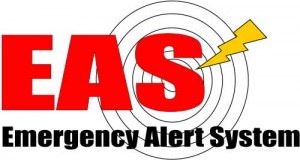First-Ever National EAS Test Could Flood PSAPs
 9-1-1 centers could experience a strong burst of calls when the first-ever national test of the Emergency Alert System (EAS) is conducted later this year. Most often, when people hear the screeching tones and realize the EAS alert is a test, they either tune it out or change the channel. But during the national EAS test, no matter where they tune, they will hear the same tones and message. Public overreaction is a distinct possibility.
9-1-1 centers could experience a strong burst of calls when the first-ever national test of the Emergency Alert System (EAS) is conducted later this year. Most often, when people hear the screeching tones and realize the EAS alert is a test, they either tune it out or change the channel. But during the national EAS test, no matter where they tune, they will hear the same tones and message. Public overreaction is a distinct possibility.
Barring a major national event between now and when the test is conducted (the date is still to be determined), this will be the first time the White House has ever taken over radio, TV, cable and certain satellite programs. Although the capability has existed since the 1950s, it wasn’t used during the Cold War or the 9/11 terrorist attacks — and it’s never been tested. Federal officials want to find out how well it works.
Most people are accustomed to local EAS tests and activations for emergencies, such as weather or AMBER alerts. However, they’re not accustomed to a test originating from the White House or on all channels simultaneously. They won’t be able to tune away from it, and the message will be different from typical tests. If citizens don’t understand that a test is being conducted, they may turn to their PSAPs for additional information.
To help prepare for the national EAS test, tests were conducted in early 2011 and 2010 during which the White House took over the airwaves only in Alaska, chosen because of its size and isolation. Bryan J. Fisher of the Alaska Department of Homeland Security and Emergency Management was in charge of the test for the state. Fisher told public safety officials and broadcasters that the national test creates “great potential for public panic. Every time the EAS goes off, your PSAP is flooded with telephone calls.”[1]
“Outreach is critical,” Fisher said.
In Alaska, broadcasters and public safety officials conducted aggressive campaigns with public service announcements, media interviews and press releases. According to Fisher, “trusted relationships” were developed with broadcasters, cable outlets and government teamed together to spread the word about the test. As a result, public overreaction did not occur.
FEMA Program Manager Manny Centeno said he considers the test to be “80% outreach and 20% technical.” He told the webinar, “We can’t get 100% communication, but we can follow best practices, such as public service announcements, social media, pre-test media interviews, flyers and news releases, and 9-1-1 call center scripts.”
Despite federal efforts, Fisher said local officials shouldn’t rely on the federal government to conduct outreach. He said, “Local officials should be heavily and directly involved in getting the message out that this is only a test.”
Fisher also said it’s equally important to get the message to dispatchers to help them respond to calls about the test.
EAS is known to have shortcomings, and the test isn’t expected to reveal a flawless system. A U.S. Government Accountability Office (GAO) report in 2009 said, “EAS is an important alerting tool, but it exhibits longstanding weaknesses that limit its effectiveness.” The report listed “a lack of reliability of the message distribution system, gaps of coverage, insufficient testing and inadequate training of personnel.”[2]
FEMA manages EAS through its Integrated Public Alert and Warning System (IPAWS) program. IPAWS is addressing weaknesses by expanding and hardening broadcast relay points. A satellite system for distributing messages has also been established. Plus, the FCC has ordered all EAS participants to upgrade their EAS equipment. Many of the changes will not have occurred by the time the national test is conducted.
In 2012, EAS will be supplemented by the launch of the Commercial Mobile Alert System (CMAS), which will provide alert broadcasts over mobile devices without need for the public to sign up in advance. Other new public alerting tools are expected to follow.
The exact date of the test has not been set, but it’s expected to occur in the fourth quarter of 2011. Officials involved in EAS hope, by then, outreach efforts by local, state and federal officials will have been implemented and proven effective. Otherwise, the public will be surprised, and overreacting callers could flood 9-1-1 centers with non-emergency calls, resulting in a dangerous situation for their communities.
About the Author
Rick Wimberly is president of Galain Solutions Inc., an independent consultancy with experience in alerts, warnings and notifications.
References
1. FEMA IPAWS Practitioner webinar: Emergency Alert System National Test Resource. April 6, 2011. Accessed April 2011: www.fema.gov/library/viewRecord.do?id=4659.
2. U.S. Government Accountability Office: Emergency Preparedness: Improved Planning and Coordination Necessary for Modernization and Integration of Public Alert and Warning System. September 2009. Accessed April 2011: www.gao.gov/new.items/d09834.pdf.
Resources
- National Alliance of State Broadcasters Association EAS website: www.easalert.org
- FCC Review of the Emergency Alert System: www.fcc.gov/Daily_Releases/Daily_Business/2011/db0210/FCC-11-12A1.pdf
- FCC Erratum — Review of the Emergency Alert System: www.fcc.gov/Daily_Releases/Daily_Business/2011/db0210/DOC-304598A1.pdf
- FEMA IPAWS, “EAS Modernization and Expansion Project”: www.fema.gov/emergency/ipaws/projects.shtm#1

